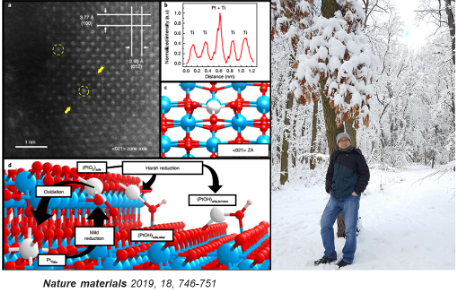Stable Atomistic Nature of A Stable Single-Atom Catalyst
Heterogeneous catalysts are widely used in many important fields, such as converting polluted gases (CO2, CO) into useful chemical compounds, producing clean fuels, solar cells, etc. These catalysts are made up of precious metals (Pt, Ru, Rh, Au, ...) existing in the form of nano-sized or scattered clusters on the metal oxide background. With this size, they are relatively expensive and do not take full advantage of the catalytic efficiency of precious metals. Therefore, scientists around the world have researched to find different methods to reduce the size of precious metals to the smallest possible size and have achieved atomic size. Therefore, this catalyst is named “monoatomic catalyst”. Furthermore, the catalytic capacity and selectivity of single-atom catalysts are far superior to those of cluster or nano-catalysts. However, because of the large specific surface energy of monoatomic catalysts, they are prone to agglomeration into large clusters in the form of clusters or nanoclusters during synthesis or catalytic reactions. Therefore, immobilizing precious metal atoms with atomic size on a support base to prevent them from agglomerating is a very important and necessary process. Many proposed solutions have been successful in synthesizing single-atom catalysts such as creating defects, attaching functional groups, etc. on supporting substrates. However, experimental scientists still have many difficulties in recognizing the exact position and electronic structure of these single-atomic catalysts even though they use modern scientific research equipment such as AC-HADDF-STEM, XPS, XANES, XRD, DRIFTS… This plays an important role in determining synthesis methods as well as applications of single-atomic catalysts. One of the effective and cost-effective methods to investigate the atomistic nature properties of single-atom catalysts is the application of density functionalization (DFT) computational chemistry. On that basis, Dr. Ho Viet Thang, along with his colleagues at the University of Milan-Bicocca, Italy, and his colleagues at the University of California Santa Barbara, USA, studied the stable atomistic nature of the dispersed Pt monoatomic catalyst on the TiO2 anatase background as well as the structural transformation dynamics of Pt under catalytic conditions (https://doi.org/10.1016/j.jcat.2018.08.025; https://doi.org/10.1038/s41563-019-0349-9). In this study, the authors combined the DFT calculation method and modern evaluation equipment, which showed that Pt does not exist in a separate form, but it is closely associated with the extra-frame O atoms and is located in the outer space in the form of PtO2 under normal conditions. However, under harsh conditions of synthesis or catalysis, these Pt atoms exist in different forms such as Pt replacing Ti atoms in the structural network or Pt bonding with OH to form a structural form (PtOH); Pt is bonded to two extracellular O atoms to form a structure of the form (PtO2). The different structural forms of this single Pt atom are clearly shown in the figure below. In addition to studying the influence of different oxide substrates on the stable electronic structure of a single atom, the research team also investigated the atomistic nature of Au atoms distributed on different metal oxide substrates, i.e, TiO2, ZrO2, CeO2, LaFeO3 (https://doi.org/10.1007/s11244-021-01514-0). The results also show that Au monoatomic stable exists on the metal oxide background in the form of AuO2 structure. These research results are completely consistent with experimental results and useful source of information for shortening the synthesis time of single-atom catalysts and for catalytic applications with high selectivity.

[Biography]
Dr. Ho Viet Thang received his PhD from Charles University, Prague, Czech Republic under the guidance of Professor Petr Nachtigall with a major in Materials Science from 10/2012 - 09/2016. Then, Dr. Ho Viet Thang continued to do post-doctoral research here until March 2017 and continued to do post-doctoral research at the Department of Materials Science at Milano-Biccoca University, Italy from April 2017 to March 3. 2019 under the guidance of Professor Gianfranco Pacchioni. From April 2019 until now, he has been a lecturer in the Department of Chemical and Materials Technology, Faculty of Chemistry, University of Science and Technology - The University of Danang.
Dr. Ho Viet Thang is currently the leader of a state-level research project funded by the National Foundation for Science and Technology Development (NAFOSTED).
Dr. Ho Viet Thang is the main author and co-author of more than 40 scientific articles, of which more than 30 articles have been published in prestigious international journals in the list of SCIE ranked Q1 and Q2.

 English
English
 Tiếng Việt
Tiếng Việt
